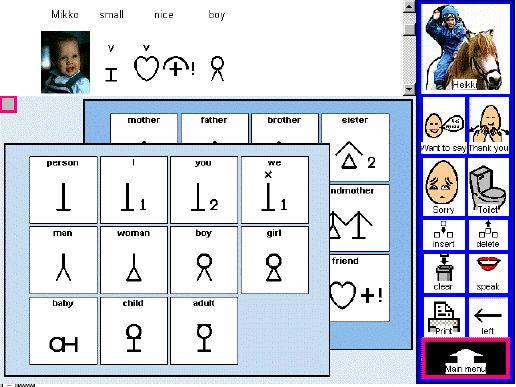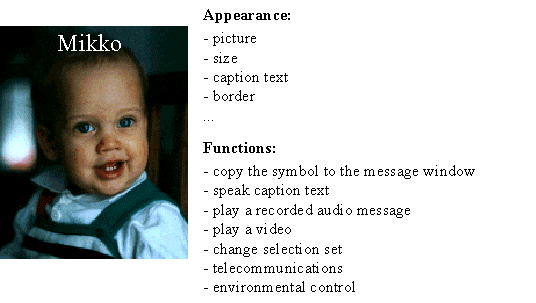

by Eija Kaasinen
A user interface that is adaptable according to the needs and preferences of the user is an efficient way to improve the usability of complex applications. The TIDE ACCESS project has developed tools, with which the adaptability can be achieved in terms of input and output techniques, appearance, information contents and functionality. VTT Information Technology has utilised the tools in communication software for speech impaired people.
The European TIDE-funded ACCESS project has worked to offer a new approach to solve computer-accessibility problems for disabled users. Main outcomes of the project include a complete user interface development environment which is platform-independent. This environment can be used to construct interfaces, for which the input/output technique and appearance is adaptable to user characteristics, abilities and preferences. The environment has been demonstrated with two kind of applications; interpersonal communication aids for speech-motor and language-cognitive impaired people and hypermedia systems for blind people. VTT in co-operation with Pikomed has been responsible for the communication device for language cognitive impaired users.
Language cognitive impaired people are unable to speak, read or write. Their typical diagnosis include stroke, mental retardation, autism, cerebral palsy and dysphasia. A communication device designed for this user group helps the users in their communication with other persons by producing messages of the picture symbols, which the user selects. The messages are spoken out with a speech synthesiser software. The display of the communication device consists of a hierarchy of selection sets, where the symbols are and a message window, where the message consisting of symbols is composed. Figure 1 shows a screen view of the communication device designed for an 8 year old boy, who communicates with Blissymbols.

Figure 1: A typical screen view of the communication software.

Figure 2: Adaptable features in an item of the user interface.
In this kind of application the adaptability in terms of input/output technique and appearance is not enough. We have enhanced the adaptability in terms of information contents (the hierarchy of the selection sets) and the functionality (what happens when the user selects a symbol). This has been achieved by encapsulating the selection sets and the functionality of the software in a database. By changing the contents of the database, the communication software can be changed without reprogramming.
Configuration software is a graphic tool, with which the therapist, the facilitator or the user herself can build and edit the selection sets for the personal communication software. The symbols, sounds, items and ready made selection sets of ACCESS symbol library can be used as material for the personal selection sets. In addition, new graphic and audio material can be imported to the database.
The hierarchy of the symbols in the selection sets can be adapted according to personal preferences, needs and abilities. Also the function or functions related to each symbol can be selected from a range of functions. The adaptability possibilities for the symbols are illustrated in figure 2. The configuration software imports MS Windows, compatible graphic files (BMP, WMF) to the symbol library. The audio output is either recorded instant messages or synthesised speech produced by a speech synthesiser software.
Pikomed, a Finnish company, which also is a partner in the ACCESS consortium, will commercialise the designed communication software. VTT Information Technology plans to implement the designed architecture solution also to other application fields, which need adaptable and adaptive appearance and functionality. An important future application field is networked multimedia services.
Please contact:
Eija Kaasinen - VTT Information Technology
Tel: +358 3 3163 323
E-mail: eija.kaasinen@vtt.fi